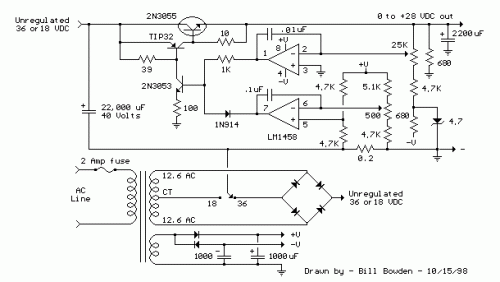- Stablised Power Supply With Short-Circuit Indication
- 3-30V 3A Adjustable Regulated DC Power Supply
- 9 Volt 2 Ampere DC Power Supply Circuit Diagram
- Adjustable 1.3-22V Regulated Power Supply
- Adjustable Current Limit For Dual Power Supply
- Quad Power Supply For Hybrid Amplifier
- Stabilized Regulated Power Supply Circuit
- Transformerless 5 Volt Power Supply
- Variable Dc Power Supply
- High-Voltage Regulator With Short Circuit Protection
- Ampere or Current Booster Circuit
- Smoke Alarm Battery Life Extender
- High Current Regulated Supply
- 2 Watt Switching Power Supply
- Variable Voltage and Current Power Supply
Variable Voltage and Current Power Supply
Description
Another method of using opamps to regulate a power supply is shown below. The power transformer requires an additional winding to supply the op-amps with a bipolar voltage (+/- 8 volts), and the negative voltage is also used to generate a reference voltage below ground so that the output voltage can be adjusted all the way down to 0. Current limiting is accomplished by sensing the voltage drop across a small resistor placed in series with the negative supply line. As the current increases, the voltage at the wiper of the 500 ohm pot rises until it becomes equal or slightly more positive than the voltage at the (+) input of the opamp. The opamp output then moves negative and reduces the voltage at the base of the 2N3053 transistor which in turn reduces the current to the 2N3055 pass transistor so that the current stays at a constant level even if the supply is shorted. Current limiting range is about 0 - 3 amps with components shown. The TIP32 and 2N3055 pass transistors should be mounted on suitable heat sinks and the 0.2 ohm current sensing resistor should be rated at 2 watts or more. The heat produced by the pass transistor will be the product of the difference in voltage between the input and output, and the load current. So, for example if the input voltage (at the collector of the pass transistor) is 25 and the output is adjusted for 6 volts and the load is drawing 1 amp, the heat dissipated by the pass transistor would be (25-6) * 1 = 19 watts. In the circuit below, the switch could be set to the 18 volt position to reduce the heat generated to about 12 watts.
